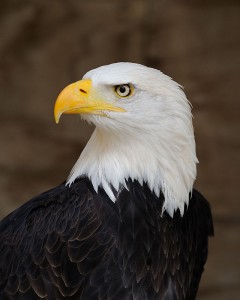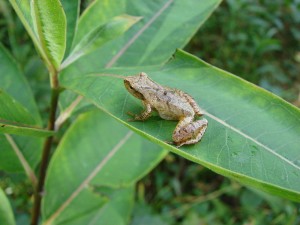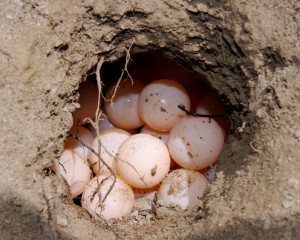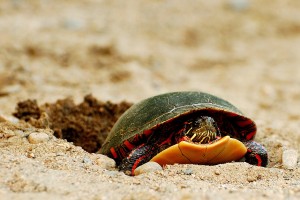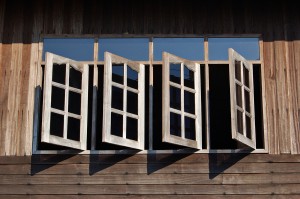by Ashton Nichols
In addition to songbirds, our Creekside is also a realm of raptors; that is to say, it is busy with that expansive group of avian species that include the hawks, and the eagles, and the owls. “Raptor” derives from a Latin word rapere, which means–as you might imagine–to seize forcefully. This morning it was just two red-tailed hawks circling high above the farm fields near us, squawking a call that is known to all of those who remember the television show Northern Exposure: “Awwkkee, aawwkkee!” they cry, as gangs of crows circle around them in small flocks, working hard to chase them away. But the red-tailed hawks often win. Today it seems like a draw, as the crows disperse and scatter into the tall trees off toward the western horizon, and the red-tails sail away into the distance in the direction of North Mountain. With this dramatic encounter of hawks and crows, I thought I was done with my bird-watching for the day, but I was not very prophetic on this blue-skied dawn.

Red-tail: Unharried on High.
photo: http://en.wikipedia.org/wiki/Redtail_hawk#mediaviewer/File:Red-tailed_hawk_in_flight.jpg
Hawks like these aggressive hunters are here almost every day. Usually it is red-tails like this pair, but sometimes it is Cooper’s hawks or sharp-shins, kestrels (not really much larger than large songbirds) or broad-wings. These hawks in their kettles all gather here because the hunting is so good: field mice and moles, voles and even big rats, all drawn by the hundreds of acres of seeded farm-fields around us, by the stacks of grain and corn in the barns, and by the smaller birds that hawks are also willing to eat. I have seen a peregrine falcon take a sparrow right out of the sky in front of me, in a flash of feathers that looked like an explosion of bird-life.
There are also cats on the farm here, as you might well expect: barn cats in their low dozens: tigers and tortoise-shells, an orange-and-white that is one of my favorites, and even a jet black bit of bad luck, but I like her a lot. Yet even all of these felines cannot keep the microtis (the word that means “small-eared” when it refers to little furry mammals) that surround us at bay. There cannot be too many cats for the hawks; there cannot be too many cats for the rats. Here at Creekside we witness the delicate balance of nature: hawks and cats, mice and rats, and even thousands upon thousands of spring-peeper frogs, but more about them and their role anon.
We also have bald eagles at Creekside this spring and early summer, at least two often-seen juvenile birds that we have been watching closely for almost six months now. We have watched them as they have grown and matured, as they soar from one wide farm-field to the other, and then as they sail away down toward the wide-open creek bed, and especially as they change their wide-winged plumage from brown-and-white splotches to the beautifully characteristic white head and tail. Bald eagles are born with almost as many white feathers as brown ones scattered throughout their wide body and wings and then, as they grow, the brown number increases, and the white one shrinks to just their heads and tails. In the male, as all good Americans know, this white ends up only covering the head and the sparkling white tail. The adult female, however, unlike most other bird species, looks almost exactly like the adult male, but she is a little bit larger all over: her wingspan is wider, she weighs a bit more, her beautifully curved bill is a bit longer, and so are the sharp rear talons on her wildly lizard-looking legs.
Several years ago, there was a registered bald eagle’s nest about five miles to the northwest of us along our same winding creek. A registered nest has watchers from the Audubon Society, and other official birding groups, who regularly report on the condition of the nest, the number of eagle’s eggs, and just how the young develop as they hatch and then mature. But these two juveniles that we have been watching this year are clearly from much closer by; the nest from which they fledged must be just down the hill from us or along the wide ox-bow that winds across and along the creek to our immediate west. These two birds fly close enough to us sometimes so that we can see their curved beaks and reptilian talons. They roost in tall pine trees nearby and the locust trees just behind the house, and then they swoop down and soar across the nearby fields and creek in search of prey. Once, at least once, we saw one of these magnificent birds with that very same prey in its talons, captured and spiked right through with razor sharp claws, a small rodent or other immature mammal, dead now and soaring off across the wide fields toward the mountain ridge above us, another kill, another capture, another protein feast for this fine national bird that we call America’s.
Finally, our owls are the last group of raptors here with us at Creekside. We have never seen one, at least we have not seen one yet, but we often hear them in numbers at night, calling from deep down in the Conodoguinet creek bed. Most often it is the barred owl, with its characteristic, “Who cooks for you all; who cooks for you?” and then sometimes, when we get lucky, we hear the noble great horned owl, with a more stately and solemn, “Whooo, whooo, whoo, whoo! Whoo, whoo, whoo, whooo!”
Some nights these owl calls even drown out the chorus of spring peeper frogs, or these two choruses–avian and reptilian–vie for supremacy, first the frogs taking over, “Kee, ke, ke, kee, keek–Kee, kee, ke, kee,” and then the owls, especially that booming great horned sound, “Whoo, whoo, whoo, whoo; whoo, whoo, whoo, whoo!” We drift off to sleep with these sounds in our heads: the huge owls off in the distance and then these tiny frogs, thousands of them not much bigger than the size of your thumbnail–just two hundred to three hundred yards away–peeping loudly: “peeeep, peeep, peep-peep, peeeep,” and we are lulled into unconsciousness by these booming repeated raptor calls followed by these delicate riparian replies.

